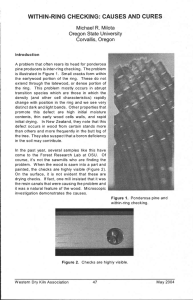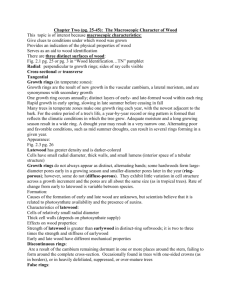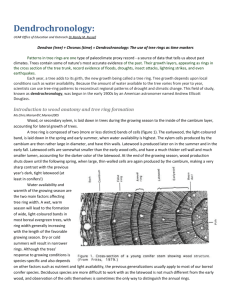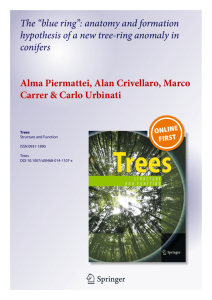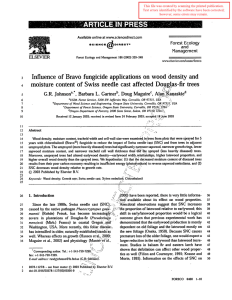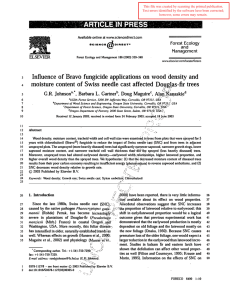NO CORRELATION BETWEEN LATEWOOD FORMATION AND LEADER GROWTH IN DOUGLAS-FIR SAPLINGS
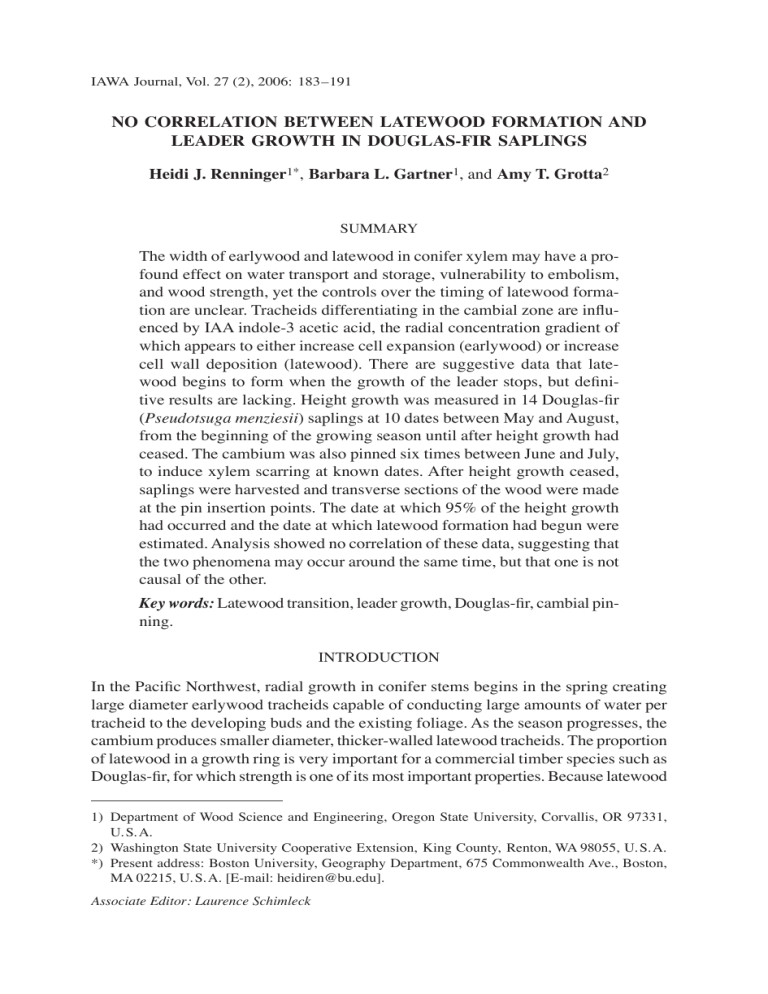
IAWA Journal, Vol. 27 (2), 2006: 183–191
NO CORRELATION BETWEEN LATEWOOD FORMATION AND
LEADER GROWTH IN DOUGLAS-FIR SAPLINGS
Heidi J. Renninger 1* , Barbara L. Gartner 1 , and Amy T. Grotta 2
SUMMARY
The width of earlywood and latewood in conifer xylem may have a profound effect on water transport and storage, vulnerability to embolism, and wood strength, yet the controls over the timing of latewood formation are unclear. Tracheids differentiating in the cambial zone are influenced by IAA indole-3 acetic acid, the radial concentration gradient of which appears to either increase cell expansion (earlywood) or increase cell wall deposition (latewood). There are suggestive data that latewood begins to form when the growth of the leader stops, but definitive results are lacking. Height growth was measured in 14 Douglas-fir
( Pseudotsuga menziesii ) saplings at 10 dates between May and August, from the beginning of the growing season until after height growth had ceased. The cambium was also pinned six times between June and July, to induce xylem scarring at known dates. After height growth ceased, saplings were harvested and transverse sections of the wood were made at the pin insertion points. The date at which 95% of the height growth had occurred and the date at which latewood formation had begun were estimated. Analysis showed no correlation of these data, suggesting that the two phenomena may occur around the same time, but that one is not causal of the other.
Key words: Latewood transition, leader growth, Douglas-fir, cambial pinning.
INTRODUCTION
In the Pacific Northwest, radial growth in conifer stems begins in the spring creating large diameter earlywood tracheids capable of conducting large amounts of water per tracheid to the developing buds and the existing foliage. As the season progresses, the cambium produces smaller diameter, thicker-walled latewood tracheids. The proportion of latewood in a growth ring is very important for a commercial timber species such as
Douglas-fir, for which strength is one of its most important properties. Because latewood
1) Department of Wood Science and Engineering, Oregon State University, Corvallis, OR 97331,
U.S.A.
2) Washington State University Cooperative Extension, King County, Renton, WA 98055, U.S.A.
*) Present address: Boston University, Geography Department, 675 Commonwealth Ave., Boston,
MA 02215, U.S.A. [E-mail: heidiren@bu.edu].
Associate Editor: Laurence Schimleck
184 IAWA Journal, Vol. 27 (2), 2006 is comprised of thick-walled cells, its proportion in the growth ring largely determines the density of the wood (Kubo & Jyodo 1996), which in turn affects its strength and stiffness. Vargas-Hernandez and Adams (1994) also found that the timing of the transition from earlywood to latewood is the main determinant for the proportion of latewood in the growth ring and, therefore, is significantly correlated with wood density.
Latewood may also provide water storage, whereas earlywood performs most of the water transport needs of the tree (Domec & Gartner 2002). In an experiment with excised earlywood and latewood, earlywood had 11 times the specific conductivity of latewood. Furthermore, earlywood gave up 10% of its conductivity at -1.3 MPa, whereas latewood had lost 40% by that point (Domec & Gartner 2002), meaning that stored water was more accessible in the latewood than in the earlywood.
Whether cambial derivatives become earlywood or latewood cells depends on the time spent in various zones of maturation. After cambial division, tracheids enter a zone of expansion where diameter and length growth occur. Next, tracheids enter a zone of secondary wall formation where thickening of the secondary wall occurs. Dodd and Fox (1990) found that it is the duration (and not the rate) of cell expansion and cell wall deposition that determines tracheid diameter and cell wall thickness, respectively. Therefore, the amount of time spent in each of these zones determines whether a tracheid is of the larger diameter, thinner-walled type (earlywood) or of the smaller diameter, thicker-walled type (latewood) (Brown 1970). Furthermore, Antonova and
Stasova (1993) reported that because the optimum temperature and precipitation value differ for cell wall formation and cell expansion, it is not possible to have thick-walled cells with large lumens. Tracheids can, therefore, either be of the earlywood or of the latewood type.
Cambial division and tracheid differentiation have long been thought to be under the control of indole-3-acetic acid (IAA) concentration within the cambial region (Larson
1969; Savidge 2000), as well as other plant growth regulators such as gibberillic acid, ethylene, abscisic acid and cytokinins (Savidge 2000). It is not the absolute concentration of IAA (Sundberg et al.
1993; Eklund et al.
1998) but the radial concentration gradient of IAA that provides a positional signal to the differentiating tracheids (Tuominen et al.
1997; Uggla et al.
1998; Sundberg et al.
2000; Savidge 2000). These studies show that a radial IAA gradient within the cambial region determines the width of the zones of tracheid development ( i.e.
, division, expansion and secondary wall formation), therefore determining how much time a particular tracheid will spend in each zone and ultimately the type of tracheid formed. Uggla et al.
(2001) provide further evidence of a radial concentration gradient of IAA and its contribution to the earlywood/latewood transition. They sampled regions of Scots pine ( Pinus sylvestris ) throughout the growing season and found that the total concentration of auxin did not change during the latewood transition, but the radial concentration gradient changed. They also found that carbohydrate availability is not a trigger for latewood formation, although they did find the highest amounts of sucrose metabolizing enzymes in tracheids undergoing secondary wall formation.
Changes in temperature, precipitation and photoperiod throughout the growing season have all been shown to alter the timing of the transition from earlywood to latewood
Renninger, Gartner & Grotta — Latewood formation in Douglas-fir 185
184 IAWA Journal, Vol. 27 (2), 2006 Renninger, Gartner & Grotta — Latewood formation in Douglas-fir 185
(Larson 1960, 1962; Zahner et al.
1964; Cregg et al.
1988; Antonova & Stasova 1993,
1997; Lebourgeois 2000). However, a particular region of the tree such as the apical bud, mature needles, newly produced needles, roots or a combination of these need to be responsible for receiving information about the environment and adjusting IAA gradients and ultimately wood formation accordingly. If the apical bud is sensing changes in temperature, precipitation and/or photoperiod, then perhaps leader growth could be correlated with latewood formation. Several authors have found that latewood formation and the completion of leader growth occur at about the same time during the growing season (Larson 1962; Sundberg et al.
2000). Emmingham (1977) found that latewood formation generally begins when leader growth reaches 90% completion in
Douglas-fir. Jayawickrama et al.
(1997) found that the date of latewood transition in loblolly pine ( Pinus taeda ) was significantly correlated with the date of height growth cessation using methods similar to those used in this study.
Although several studies have shown that latewood formation and leader growth completion occur around the same time, evidence that leader growth completion causes latewood formation is lacking. This evidence is important because, if wood formation can be correlated to an easily visible feature of a tree like leader growth, then latewood proportion, and in turn an estimate of wood density, could be determined by evaluating leader growth rather than by semi-destructive means (tree coring, etc.
). Also, if we find that the apical bud is important in determining IAA concentrations and wood formation, then potentially, manipulations could be performed to alter IAA concentrations and control the type of wood that is produced by the cambium.
MATERIALS AND METHODS
Douglas-fir seedlings were grown in un-irrigated, raised beds until they reached five years of age. Fourteen saplings were chosen at random from the several hundred available, after eliminating the shortest individuals and those with a forked top or with a branch at an anomalous angle (competing for leader dominance). Trees averaged about
1.2 m tall at the start of the growing season. The length of the current yearʼs leader was determined at nine dates between 16 May and 23 August 2002. Dates are reported here as both Julian Date (JD) and calendar date. Current yearʼs growth was measured from the base of the annual bud scar to the tip of the current-yearʼs bud. The cambia of the same 14 saplings were also pinned six times during June and July, to induce xylem scarring at known dates. Stems were pinned approximately 50 cm above the ground in wood that was three years old. There was no branch recession, so this was within the crown. Pinning was accomplished by inserting, then immediately removing, a 0.5-mm-diameter insect pin into the stem causing the cambium at this site to form abnormal callus tissue rather than normal tracheids (Wolter 1968). This scarring allows for the determination of cambial position throughout the growing season at each of the dates when pinning occurred.
After height growth had ceased, the saplings were harvested. Twenty-cm-long stem segments containing the pinned regions were cut off and then stored in the freezer. Next, the segments were cut smaller and the wood was sectioned at the pin insertion points
186 IAWA Journal, Vol. 27 (2), 2006 Renninger, Gartner & Grotta — Latewood formation in Douglas-fir 187
Fig. 1. Transverse section of pinning scar showing earlywood width (A), width of growth ring completed at time of pinning (B) and width of growth ring (C).
making 30μ m-thick transverse sections with a sliding microtome. The sections were stained with safranin and mounted in glycerine. Digital images of each slide were then taken using a CoolSnap camera (Roper Scientific Photometric, Tucson, Arizona, USA) on a Nikon SMZ-2T stereoscopic zoom microscope (Melville, New York, USA) using an optical magnification of × 1.8, but with further digital enlargement when the images were projected on the computer monitor. Distances (see below) were then measured with a ruler placed on the computer monitor.
For each of the 14 samples, numerous transverse slides were made going from about
0.5 mm below where the pin was inserted to about 0.5 mm above that point. The slides were inspected to find the one for each sample that most clearly showed the maximum pin insertion. On that slide we measured growth ring width, earlywood width and growth ring width completed at time of pinning (Fig.
1). The earlywood/latewood transition was determined visually by a discernible change in cell wall thickness, resulting in a band of darker cells. This process roughly followed Morkʼs definition of a latewood tracheid as one in which the width of the common cell wall multiplied by two is equal to or greater than the width of an individual lumen (Denne 1988). The width of the growth ring completed at the time of pinning was considered to be the length from the beginning of the growth ring to the first abnormally formed callus cell in the pinning scar (B on Fig.
1).
For each sapling, we estimated the date at which latewood formation began, as follows. First, for each pinning date the proportion of final growth ring width completed
(B/C on Fig.
1) was calculated by dividing growth ring width completed at time of pinning (B on Fig.
1) by the total growth ring width (C on Fig.
1). Therefore, the pin-
186 IAWA Journal, Vol. 27 (2), 2006 Renninger, Gartner & Grotta — Latewood formation in Douglas-fir 187
60
50
40
30
20
100
90
80
70
10
0
130 140 150 160
1 June
170 180 190
1 July
Julian Date
200 210 220 230
1 August
Fig. 2. Proportion of final growth ring width (dashed line) and final height growth (solid line) throughout the growing season. These curves were used to estimate when latewood formation
(D) and 95% leader growth (E) occurred in each of the Douglas-fir saplings (mean ± SE, n = 14).
210
0
0
205
0
0
0
200
0
0
0
0
0
0
195
0
190
0
185
0
180
180 185 190 195 200 205 210
Completion of 95% leader growth (JD)
Fig. 3. Date at which latewood formation began vs. the date at which 95% leader growth had occurred for 14 Douglas-fir saplings. Diagonal line shows where the beginning of latewood formation and the completion of 95% leader growth occur on the same date (JD is Julian Date).
188 IAWA Journal, Vol. 27 (2), 2006 ning scars provided a way of tracking the growth ring progress throughout the growing season. Then, we graphed the proportion of final growth ring width completed (B/C on Fig.
1) vs. date (dashed line, Fig. 2). This procedure was done separately for each of the 14 saplings, but Figure 2 is a mean of all 14, to show the trends. Finally, for each of the 14 saplings we calculated the earlywood proportion of the ring (A/C). For this estimate, we used the mean of the values of the third and fourth pinning dates because the transition from earlywood to latewood occurred during this time period in most of the sampled trees. The mean for all trees was 86%. We then found the date (bottom axis of Fig. 2) at which the latewood transition occurred by reading where on the graph of
B/C the value A/C occurred (line D, Fig. 2).
For each sapling, we also estimated the date of 95% completion of leader growth as follows. First, the proportion of final height growth completed was obtained by dividing the height measured at each measurement date by the final height. These data were plotted as proportion of final height growth versus time (Fig. 2). The date at which
95% of the height growth occurred was interpolated from this line (line E, Fig. 2) and again this process was done separately for each of the fourteen saplings.
For each sapling we therefore had two values: the date at which latewood formation began (from line D, Fig. 2), and the date at which 95% of the leader growth had occurred (from line E, Fig. 2). We plotted these values against one another (Fig. 3) and calculated an R 2 value and a p-value for the regression data in order to determine if the two events are correlated.
RESULTS
During the period in which we studied growth ring formation, roughly the second half of the growing season, growth ring width increased about linearly until the last pin was inserted (Fig. 2). On average, latewood formation started on JD 198 (17 July), but it ranged from JD 184 to JD 208 in the 14 seedlings (3 July to 27 July) (Fig. 3).
Leader growth had a sigmoidal pattern (Fig. 2). The average date at which 95% of the leader growth was complete was JD 188 (7 July). However, there was considerable variability within the 14 saplings, with this date ranging from JD 180 to JD 195 (30
June to 14 July) (Fig. 3). Most individuals completed 95% leader growth before they began to make latewood (Fig. 2 & 3).
There was no significant correlation between the date at which 95% leader growth had occurred and the date at which latewood formation began for the 14 saplings (Fig. 3,
R 2 = 0.001157, p-value = 0.9081). The dates of leader growth and latewood formation overlap suggesting that cessation of leader growth and latewood formation occur at around the same time, but there is no pattern in the data suggesting a direct correlation between the two developmental stages (Fig. 3).
DISCUSSION
In the current study, the average date of the beginning of latewood formation was JD 198
(17 July), with onset ranging from JD 184 to JD 208. The exact dates for the beginning of latewood formation will, however, depend on where in the crown one measures. This
Renninger, Gartner & Grotta — Latewood formation in Douglas-fir 189
188 IAWA Journal, Vol. 27 (2), 2006 Renninger, Gartner & Grotta — Latewood formation in Douglas-fir 189 was not a factor for the saplings in this study (which exhibited no crown recession), but for older, taller trees the location of pinning could have more of an effect. The dates found in this study are similar to those reported for balsam fir ( Abies balsamea ) in the
Canadian boreal forest which had a latewood transition between 2 July and 19 July
(Deslaurier et al.
2003). However, the dates found in this study are later than those reported by Vargas-Hernandez and Adams (1994) for 15-year-old coastal Douglas-fir trees. They found the latewood transition to occur between 19 June and 6 July.
There was no direct correlation between the date of latewood formation and the date at which most of the height growth of the leader had occurred. However, because both latewood formation and leader growth cessation occur at approximately the same time in the growing season, it is possible that both phenomena are correlated with the same environmental cue independently of one another. These environmental cues could include temperature, precipitation, water stress and/or photoperiod (Larson 1960, 1962;
Zahner et al.
1964; Cregg et al.
1988; Antonova & Stasova 1993, 1997; Lebourgeois
2000). Several studies have addressed photoperiod and the effect of long days and short days on cambial growth. Larson (1960) subjected red pine trees to various treatments and found that wood formation could be controlled by day length. Trees grown under long-day conditions continued to produce earlywood until they were given short-day conditions, at which point they began producing latewood. He also found that false rings could be produced if trees were given long-day conditions after receiving short-day conditions. In a similar experiment, Larson (1962) exposed buds and needles separately to different photoperiods to determine the effect on wood formation. He found that long days promoted needle elongation and earlywood production and short days caused cessation of needle elongation and formation of latewood tracheids.
One of the problems with correlating photoperiod with latewood formation is that it would suggest that all individuals would have the same date of transition and that latewood forms at the same time each growing season no matter what other environmental conditions are affecting tree growth. Neither of these patterns are supported by the literature. As reported here and in papers cited above, there is individual variability in the date of latewood transition. If environmental conditions are less than optimal then latewood formation can occur earlier in the growing season. For example, precipitation and moisture stress have a significant impact in determining the transition from earlywood to latewood (Brix 1972; Cregg et al.
1988; Antonova & Stasova 1997). Cregg et al.
(1988) found that the latewood transition in loblolly pine ( Pinus taeda ) is associated with increased evaporative demand and decreased soil moisture content. Brix (1972) found similar results for Douglas-fir suggesting that water stress affects the time of the latewood transition. Zahner (1962) and Zahner et al.
(1964) found similar results in their irrigation studies. They found that trees growing in irrigated sites produced earlywood late into the growing season, whereas trees exposed to drought conditions began producing latewood earlier in the season.
Temperature also has an effect on cambial activity and the maturation of tracheids within the cambial zone. Cregg et al.
(1988) found contrasting effects of temperature early and later in the growing season. They found that increased temperatures promoted basal area growth early in the growing season but limited growth later in the growing
190 IAWA Journal, Vol. 27 (2), 2006 season. Antonova and Stasova (1993) found a different influence of temperature in their study of Scots pine ( Pinus sylvestris ). They found that temperature was the main variable influencing secondary wall formation while precipitation was the primary variable influencing cell expansion and cambial division. Therefore, precipitation, temperature and photoperiod all interact to influence cambial division and tracheid development and ultimately determine the types of tracheids (earlywood or latewood) produced throughout the growing season. These environmental factors stimulate one or various plant organs (apical bud, developing needles, mature needles, roots, etc.
), changing concentrations of plant growth regulators (IAA, gibberillic acid, ethylene, abscisic acid and cytokinins, etc.
) in the cambial region and controlling the differentiation of tracheids.
Although cessation of leader growth has not been shown to be correlated with latewood formation, foliar elongation still stands as a possible indicator for the transition from earlywood to latewood. Wareing and Roberts (1956) removed the apical bud from black locust ( Robinia pseudoacacia ) seedlings leaving only mature leaves and found that latewood could still be produced, suggesting that latewood formation is not dependent on apical activity but on foliar development. Larson (1964) found that in red pine ( Pinus resinosa ) the transition from earlywood to latewood was associated with cessation of needle growth and that short days caused needle growth to slow and promoted earlier cessation of needle growth. Larson (1969) also found that, when needle growth is suppressed by drought, latewood tracheids are formed. If needle growth is reinitiated through watering, earlywood is produced. Therefore, needle elongation appears to be a promising correlate with latewood formation. Moreover, needles can respond to environmental cues such as changes in temperature, water availability and photoperiod to vary IAA gradients within the cambial region. More research on the effect of needle elongation on plant growth regulators and latewood production may be fruitful.
REFERENCES
Antonova, G.F. & V.V. Stasova. 1993. Effects of environmental factors on wood formation in
Scots pine stems. Trees 7: 214–219.
Antonova, G.F. & V.V. Stasova. 1997. Effects of environmental factors on wood formation in larch ( Larix sibirica Ldb.) stems. Trees 11: 462–468.
Brix, H. 1972. Nitrogen fertilization and water effects on photosynthesis and earlywood-latewood production in Douglas-fir. Can. J. For. Res. 2: 467–478.
Brown, C.L. 1970. Physiology of wood formation in conifers. Wood Science 3: 8–22.
Cregg, B.M., P.M. Dougherty & T.C. Hennessey. 1988. Growth and wood quality of young loblolly pine trees in relation to stand density and climatic factors. Can. J. For. Res. 18: 851–
858.
Denne, M.P. 1988. Definition of latewood according to Mork (1928). IAWA Bull. n.s. 10: 59–
62.
Deslaurier, A., H. Morin & Y. Begin. 2003. Cellular phenology of annual ring formation of Abies balsamea in the Quebec boreal forest (Canada). Can. J. For. Res. 33: 190–200.
Dodd, R.S. & P. Fox. 1990. Kinetics of tracheid differentiation in Douglas-fir. Annals of Botany
65: 649–657.
Domec, J.C. & B.L. Gartner. 2002. How do water transport and water storage differ in coniferous earlywood and latewood? J. Exper. Bot. 53: 2369–2379.
Renninger, Gartner & Grotta — Latewood formation in Douglas-fir 191
190 IAWA Journal, Vol. 27 (2), 2006 Renninger, Gartner & Grotta — Latewood formation in Douglas-fir 191
Eklund, L., C.H.A. Little & R.T. Riding. 1998. Concentrations of oxygen and indole-3-acetic acid in the cambial region during latewood formation and dormancy development in Picea abies stems. J. Exper. Bot. 49 (313): 205–211.
Emmingham, W.H. 1977. Comparison of selected Douglas-fir seed sources for cambial and leader growth patterns in four western Oregon environments. Can. J. For. Res. 7: 154–164.
Jayawickrama, K.J.S., S.E. McKeand, J.B. Jett & E.A. Wheeler. 1997. Date of earlywood-latewood transition in provenances and families of loblolly pine, and its relationship to growth phenology and juvenile wood specific gravity. Can. J. For. Res. 27: 1245–1253.
Kubo, T. & S. Jyodo. 1996. Characteristics of the annual ring structure related to wood density variation in sugi ( Cryptomeria japonica ). Mokuzai Gakkaishi 42: 1156–1162.
Larson, P.R. 1960. A physiological consideration of the springwood summerwood transition in red pine. Forest Science 6: 110–122.
Larson, P.R. 1962. The indirect effect of photoperiod on tracheid diameter in Pinus resinosa .
Amer. J. Bot. 49: 132–137.
Larson, P.R. 1964. Contribution of different-aged needles to growth and wood formation of young red pines. Forest Science 10: 224–238.
Larson, P.R. 1969. Wood formation and the concept of wood quality. Yale University: School of Forestry Bulletin 74: 24–53.
Lebourgeois, F. 2000. Climatic signals in earlywood, latewood and total ring width of Corsican pine from western France. Annals For. Sci. 57: 155–164.
Savidge, R.A. 2000. Intrinsic regulation of cambial growth. J. Plant Growth Regulation 20:
52–77.
Sundberg, B., A. Ericsson, C.H.A. Little, T. Nasholm & R. Gref. 1993. The relationship between crown size and ring width in Pinus sylvestris L. stems: dependence on indole-3-acetic acid, carbohydrates and nitrogen in the cambial region. Tree Physiology 12: 347–362.
Sundberg, B., C. Uggla & H. Tuominen. 2000. Cambial growth and auxin gradients. In: R.A.
Savidge, J.R. Bennet & R. Napier (eds.), Cell and molecular biology of wood formation:
169–188. Bios Scientific Publishers Ltd., Oxford.
Tuominen, H., L. Puech, S. Fink & B. Sundberg. 1997. A radial concentration gradient of indole-
3-acetic acid is related to secondary xylem development in hybrid aspen. Plant Physiology
115: 577–585.
Uggla, C., E. Magel, T. Moritz & B. Sundberg. 2001. Function and dynamics of auxin and carbohydrates during earlywood/latewood transition in Scots pine. Plant Physiology 125: 2029–
2039.
Uggla, C., E.J. Mellerowicz & B. Sundberg. 1998. Indole-3-acetic acid controls cambial growth in Scots pine by positional signaling. Plant Physiology 117: 113–121.
Vargas-Hernandez, J. & W.T. Adams. 1994. Genetic relationships between wood density components and cambial growth rhythm in young coastal Douglas-fir. Can. J. For. Res. 24:
1871–1876.
Wareing, P.F. & D.L. Roberts. 1956. Photoperiodic control of cambial activity in Robinia pseudoacacia L. New Phytologist 55: 356–366.
Wolter, K.E. 1968. A new method for marking xylem growth. Forest Science 14: 102–104.
Zahner, R. 1962. Terminal growth and wood formation by juvenile loblolly pine under two soil moisture regimes. Forest Science 8: 345–352.
Zahner, R., J.E. Lotan & W.D. Baughman. 1964. Earlywood-latewood features of red pine grown under simulated drought and irrigation. Forest Science 10: 361–370.
